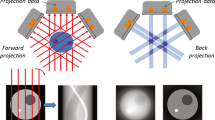Abstract
Lack of reliability, user dissatisfaction and errors in determining coronary vessel wall characteristics are challenging issues in quantitative coronary analysis (QCA). A new approach is proposed for QCA that tackles these issues. The proposed approach extracts the coronary vessel edges by applying dynamic programming techniques that use human-based decision criteria, adaptive edge detection and feature-based cost minimisation. This approach uses image gradient, image intensity, boundary continuity and adaptive thresholding to gain maximum quality assurance. The validation of this approach was conducted through modelled phantoms and real X-ray angiograms. The results show that the accuracies obtained were 0.0116 mm and 0.06 mm, respectively, and the precisions were 0.0263 mm, and 0.04 mm, respectively. The proposed approach is reliable, reproducible and user friendly and provides high precision compared with recently published results. Furthermore, the significance of the proposed approach and its limitations are also discussed.
Similar content being viewed by others
References
Al-Fahoum, A. S., andReza, A. M. (2001): ‘Combined edge crispiness and statistical differencing for deblocking JPEG compressed images’,IEEE Trans. Image Process.,10, pp. 1288–1298
Al-Fahoum, A. S., Al-Omari, F., andAl-Jarrah, M. (2002): ‘A new edge tracking mechanism for quantitative coronary analysis.’ Proc. 9th Int. Workshop on Systems, signals and image processing, Manchester, England, pp. 566–573
Al-Fahoum, A. S. (2002): ‘A new iterative approach for quantitative coronary analysis’, ICBME2002, Swissotel The Stamford, Singapore, D4I-0930, p. 121
Bresler, Y., andMacowski, A. (1988): ‘Three-dimensional reconstruction from projections with incomplete and noisy data by object estimation’,IEEE Trans. Acoust. Speech Signal Process.,35, pp. 1139–1152
Brown, B. G., Bolson, E. L., andDoge, H. T. (1986): ‘Quantitative computer techniques for analyzing coronary arteriograms’,Prog. Cardiovasc. Dis.,28, pp. 403–418
Canny, J. (1986): ‘A computational approach to edge detection’,IEEE Trans. Pattern Anal. Mach. Intell.,8, pp. 679–698
Carey, W. K., Chung, D. B., andHemami, S. S. (1999): ‘Regularity-preserving image interpolation’,IEEE Trans. Image Process.,8, pp. 1293–1297
Chan, R., Karl, W. C., andLees, R. S. (2000): ‘A new model-based technique for enhanced small-vessel measurements in X-ray cine-angiograms’,IEEE Trans. Med. Imag.,19, pp. 243–255
Eichel, P., Delp, E., Koral, K., andBuda, A. (1988): ‘A method for a fully automatic definition of coronary arterial edge from cine-angiograms’,IEEE Trans. Med. Imag.,7, pp. 313–320
Figueiredo, M. A. T., andLeitao, J. M. N. (1995): ‘A nonsmoothing approach to the estimation of vessel contours in angiograms’,IEEE Trans. Med. Imag.,14, pp. 162–172
Fleagle, S., Johnson, M., Wilbricht, C., Skorton, D., Wilson, R., White, C., Marcus, M., andCollins, C. (1989): ‘Automated analysis of coronary arterial morphology in cine, angiograms: geometric and physiologic validation in humans’,IEEE Trans. Med. Imag.,8, pp. 387–400
Fleming, R. W., Kikeeide, R. C., Smalling, R., andGould, K. L. (1991): ‘Patterns in visual interpretation of coronary arteriograms as detected by quantitative coronary arteriography’,J. Am. Coll. Cardiol.,18, pp. 945–951
Greenspan, H., Laifenfeld, M., Einav, S., andBarnea, O. (2001): ‘Evaluation of center-line extraction algorithms in quantitative coronary angiography’,IEEE Trans. Image Process.,20, pp. 928–941
Gurley, J. C., Nissen, S. E., Booth, D. C., andDeMaria, A. N. (1992): ‘Influence of operator and patient dependent variables on suitability of automated quantitative coronary arteriography for routine clinical use’,J. Am. Coll. Cardiol.,19, pp. 1237–1243
Herrington, D. M., Siebes, M., andWalford, G. D. (1993): ‘Sources of error in quantitative coronary angiography’,Cathet. Cardiovasc. Diagn.,29, pp. 314–321
Khadra, L., Al-Fahoum, A. S., andAl-Nashash, H. (1997): ‘Detection of life threatening cardiac arrhythmias using wavelet transformation’,Med. Biol. Eng. Comput.,35, pp. 626–632
Klein, A. K., Lee, F., andAmini, A. A. (1997): ‘Quantitative coronary angiography with deformable spline models’,IEEE Trans. Med. Imag.,16, pp. 468–482
Liu, I., andSun, Y. (1993): ‘Recursive tracking of vascular networks in angiograms based on the detection-deletion scheme’,IEEE Trans. Med. Imag.,12, pp. 334–341
Mancini, G. B. J. (1991): ‘Quantitative coronary arteiographic methods in the interventional catheterization laboratory: an update and perspective’,J. Am. Coll. Cardiol.,17, pp. 23B-33B
Pappas, T., andLim, J. (1988): ‘A new method for estimation of coronary artery dimensions in angiograms’,IEEE Trans. Acoust. Speech Signal Process.,36, pp. 1501–1513
Reiber, J. H. C., Goedhart, B., Brand, G., Schiemanack, L., andZwet, P. V. (1997): ‘Quantitative coronary arteriography: current status and future’,Heart Vessels,12, pp. 209–211
Skorton, D. J., andCollins, S. N. (1985): ‘New directions in cardiac imaging’,Ann. Int. Med.,102, pp. 795–799
Sonka, M., Winniford, M. D., andCollins, S. M. (1995): ‘Robust simultaneous detection of coronary borders in complex images’,IEEE Trans. Med. Imag.,14, pp. 151–161
Sonka, M., Reddy, G. K., Winniford, M. D., andCollins, S. M. (1997): ‘Adaptive approach to accurate analysis of small-diameter vessels in cine-angiograms’,IEEE Trans. Med. Imag.,16, pp. 87–94
Sun, Y. (1989): ‘Automated identification of vessel contours in coronary arteriograms by an adaptive tracking algorithm’,IEEE Trans. Med. Imag.,8, pp. 78–88
Sun, Y. (1990): ‘Spatial frequency characteristics of vessel geometry and densitometry in coronary angiograms’,Opt. Eng.,29, pp. 1255–1259
Zwet, P. V., andReiber, J. H. C. (1992): ‘A new algorithm to detect coronary boundaries: the gradient field transform’,Comput. Cardiol., pp. 107–110
Zwet, P. V., andReiber, J. H. C. (1994): ‘A new approach for the quantification of complex lesion morphology: the gradient field transform; Basic principles and validation results’,J. Am. Coll. Cardiol.,24, pp. 216–224
Zwet, P. V., Nettesheim, M., Gerbrands, J. J., andReiber, J. H. C. (1998): ‘Derivation of optimum filters for the detection of coronary arteries’,IEEE Trans. Med. Imag.,17, pp. 108–120
Author information
Authors and Affiliations
Corresponding author
Rights and permissions
About this article
Cite this article
Al-Fahoum, A.S. Adaptive edge localisation approach for quantitative coronary analysis. Med. Biol. Eng. Comput. 41, 425–431 (2003). https://doi.org/10.1007/BF02348085
Received:
Accepted:
Issue Date:
DOI: https://doi.org/10.1007/BF02348085




